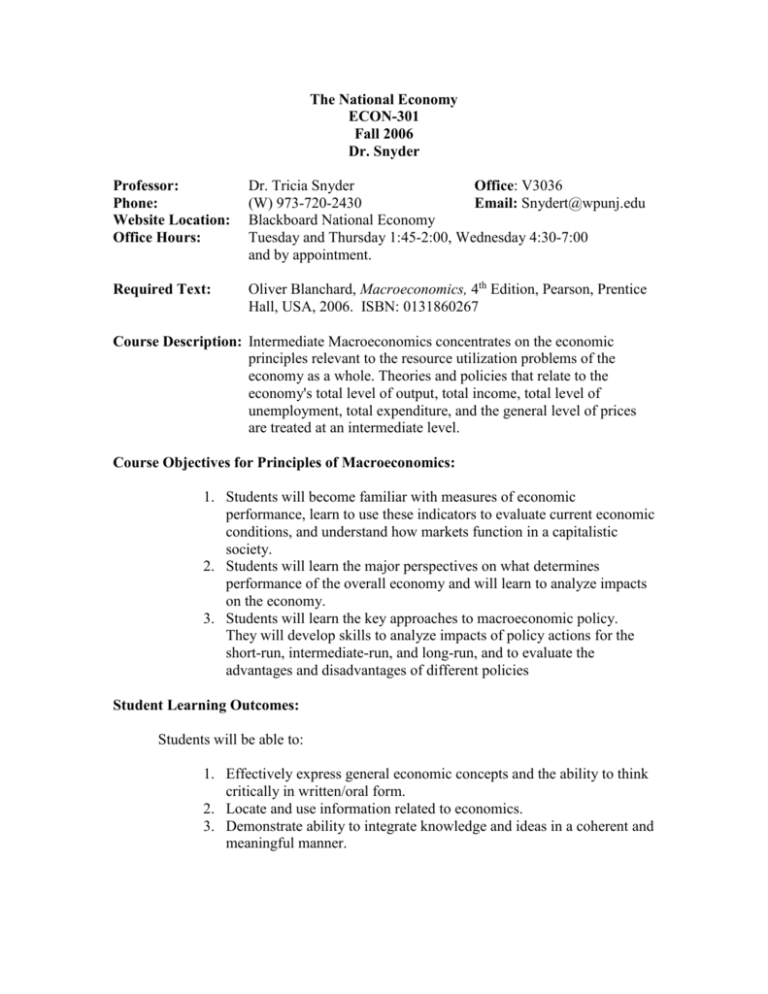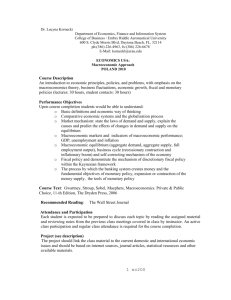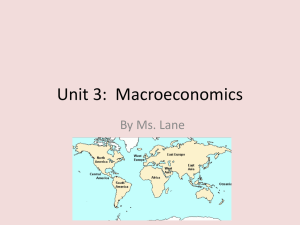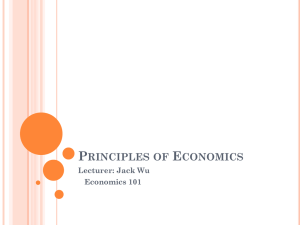
The National Economy
ECON-301
Fall 2006
Dr. Snyder
Professor:
Phone:
Website Location:
Office Hours:
Dr. Tricia Snyder
Office: V3036
(W) 973-720-2430
Email: Snydert@wpunj.edu
Blackboard National Economy
Tuesday and Thursday 1:45-2:00, Wednesday 4:30-7:00
and by appointment.
Required Text:
Oliver Blanchard, Macroeconomics, 4th Edition, Pearson, Prentice
Hall, USA, 2006. ISBN: 0131860267
Course Description: Intermediate Macroeconomics concentrates on the economic
principles relevant to the resource utilization problems of the
economy as a whole. Theories and policies that relate to the
economy's total level of output, total income, total level of
unemployment, total expenditure, and the general level of prices
are treated at an intermediate level.
Course Objectives for Principles of Macroeconomics:
1. Students will become familiar with measures of economic
performance, learn to use these indicators to evaluate current economic
conditions, and understand how markets function in a capitalistic
society.
2. Students will learn the major perspectives on what determines
performance of the overall economy and will learn to analyze impacts
on the economy.
3. Students will learn the key approaches to macroeconomic policy.
They will develop skills to analyze impacts of policy actions for the
short-run, intermediate-run, and long-run, and to evaluate the
advantages and disadvantages of different policies
Student Learning Outcomes:
Students will be able to:
1. Effectively express general economic concepts and the ability to think
critically in written/oral form.
2. Locate and use information related to economics.
3. Demonstrate ability to integrate knowledge and ideas in a coherent and
meaningful manner.
During the course students will learn how to:
1. Use supply and demand to explain various economic phenomena and
principles.
2. Explain the measurement and importance of GDP, inflation,
unemployment, money, and trade. Be able to describe the cause and
effect of changes in all of these variables.
3. Read and explain the content of economic materials from a secondary
source (such as the Wall Street Journal, New York Times, etc.) Relate
economic concepts to these real world events and critically evaluate
the impact of economic policy.
4. Compare and contrast various economic theories and policies. This
includes being able to critically analyze the Neo-Classical,
Monetarists, and Keynesian theories and policies.
Topical Outline of the Course Content:
SUBJECT
I.
II.
READINGS
INTRODUCTION TO MACROECONOMICS
Ch. 1,2
A. Macroeconomic tour/Introduction to Macroeconomics
B. Measuring economic performance/economic indicators
C. WSJ - output, employment, prices, interest rates, inflation,
real GDP, M1, M2, CPI, PPI, exchange rates.
Ch. 1.
Ch. 2,
WSJ
The Short-Run
Ch. 3-5
A. The Goods Market
– GDP, AD and its components, Investment and Savings
B. The Financial Markets
- Demand for money, Interest Rates
C. The IS-LM Model
- The Goods Market and the IS Curve, the Financial
Markets and the LM Curve, IS and LM together
D. The Labor Market
Ch. 3
Ch. 4
Ch. 5
Ch. 6
EXAM I
Ch. 1-6
III.
The Medium Run
Ch. 7-9
A. AS/AD
B. Natural Rate, Phillips Curve, and inflation
C. Extensions and Open Economy
Ch. 7
Ch. 8, 9
Ch. 14-21
1.
2.
3.
4.
5.
Expectations
New Keynesian
Modern Monetary Policy
Modern Fiscal Policy
Open Economy
EXAM II
Ch. 6-9, 14-21
IV.
The Long Run
Ch. 10-13
A. The Long-Run and Solow’s Growth Model
Ch. 10-13
FINAL EXAM
All Chapters
Grading Policy
Class Participation and HW:
3 Exams
Double Entry Journal
Economic Indicators Project
Class participation:
Homework Assignments:
Exams:
10%
20% each
10%
20%
In-Class Problems and Take Home Assignments will count
for 10% of your final grade.
3 Tests will be given; each test is weighted equally and is
worth 20% of your final grade.
The Macroeconomic Project: Double Entry Journal and Economic Indicators
1) Double Entry Journal
Purpose: The purpose of the double entry journal is to keep a log of current events that
should help students to observe the trends in the national economy. This should help
students see how daily real life events affect the economy.
Assignment: Students will keep a running double entry journal of current economic
events that affect the major economic concerns: 1) Economic Growth, 2) Inflation, 3)
Unemployment and 4) Output (including the components of Aggregate Demand, which
are Consumption, Investment, Government Spending, and Net Exports.) It should also
include 5) changes in monetary policy via changes in the Federal Funds interest rate and
6) changes in fiscal policy via changes in tax policy and government spending. Each
journal entry should discuss and evaluate the events impact on the AD/AS curve (how it
would cause a shift in either curve) and its overall impact on unemployment, inflation,
GDP, and economic growth.
Summary Statement
At the end of the journal, you should provide a 1-2 page summary of the current events
logged in your journal and their impact on the national economy. More specifically, your
summary should include the following 3 steps.
1) Based on the log of information that you have collected, list 4-6 economic trends
that you have noticed over the course of the semester.
2) After examining the trends, write a general statement of the overall state of the
economy today.
3) Using the statement in step 2, write a paragraph that uses the 4-6 economic trends
in step 1 to support the statement.
Due Date: The Double Entry Journal is due twice during the semester: 10/16 and 11/30.
2) Economic Indicators
Purpose: The purpose of the economic indicators assignment is to help students better
connect economic theory to real life events. After evaluating the data and determining
where the economy is going, students should develop a better understanding of how
monetary and fiscal policy can guide the economy.
Assignment: Economic Report to President Bush and Chairman Bernanke
In small groups of 3-5, write and orally present an economic report of current and future
economic conditions as if you were presenting it to President Bush and the Federal
Reserve Chairman Bernanke. The report should clearly define 1) the current economic
conditions and forecast based on economic indicators data, 2) a brief overview of
economic theory, 3) an assessment of risk, 4) guidance and monetary and fiscal policy
action recommendations. This report will be orally presented and recorded in groups
using power point for a 20 minute presentation at the end of the semester in the Russ
Berie Institute.
Part 1 – Economic Indicators Data
Economic indicators should be tracked starting September 2004 to November 30th.
A) Each series below should be tracked and presented in numerical form in an excel
spreadsheet. (Place the date in the left hand column, and each series in the top
row.)
B) Each series should be presented graphically overtime and analyzed for its
direction and strength.
C) Using the data, students should forecast future growth in output (real GDP) and
inflation (change in CPI).
Economic indicators to track in the project include:
1) Interest Rates (r):
Measured as Federal Funds interest rate, the 10-year TBond rate and the term structure of interest rates.
2) Prices (P) and Inflation:
Prices measured as PPI- producer price index, CPI –
consumer price index, and Inflation measured as the change
in PCE (personal consumption expenditures) and CPI
3) Output and its
Components:
Real GDP (output) and its components (real Consumption,
real Investment – including residential fixed investment
(the housing market), business fixed investment, and
inventories, Government Spending (G), and real Net
Exports (NX)).
Unemployment Rate (U):
The Unemployment Rate.
Exchange Rates:
Euro, Yen, Yuan.
This information can be found at http://research.stlouisfed.org/fred2/. It may also be obtained
at WWW.wsj.com, http://www.bls.gov/, http://www.bea.doc.gov/, or Datastream.
Part 2 – Economic Theory
Students should present a brief overview of macroeconomic theory and how it relates to
the economic indicators data in the:
1) Short-run – IS/LM
2) Medium-run – AS/AD, Phillips Curve
3) Long-run – Solow’s Growth Model
This overview should discuss the impacts on inflation, output, economic growth and
unemployment.
Part 3 – Assessment and Risk
Using a combination of economic theory, data, and information obtained in your double
entry journals, students should assess the current state of the economy regarding inflation,
output, unemployment and economic growth.
Students should also include the potential current and future risks to the economy and
how they impact output and inflation. This discussion may include but is not limited to a
discussion of the potential impacts of the stock market, a housing bubble, oil shocks,
government conflicts, the Trade Deficit, and the National Debt.
Part 4 – Guidance and Policy Actions
1) Students should present their monetary policy recommendations. Students should
discuss and defend why they have chosen such policies and their impacts on the
economy, especially inflation and output.
2) Students should present their fiscal policy recommendations. Students should
discuss and defend why they have chosen such policies and their impacts on the
economy, especially inflation and output.
Part 5 – Alternative Views and Future Issues
Present any data or theory suggestions that would lead to a different view and alternative
policy recommendations that should be considered.
Discuss any future potential issues that you see on the near horizon.












